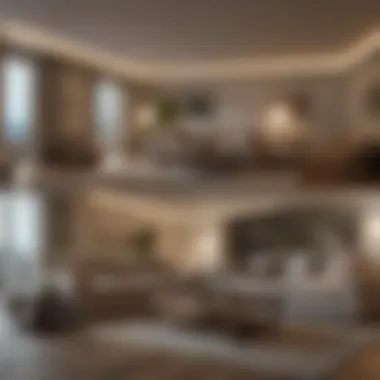Local Power Outages: Causes, Solutions, and Impacts


Intro
Localized power outages within homes, particularly in individual rooms, can be a frustrating experience. This article dives into the intricacies surrounding these outages. It aims to unpack the underlying causes, troubleshooting methods, and solutions to prevent such incidents. The impact on the aesthetics and functionality of beautifully designed spaces is also a core focus.
Understanding the dynamics of these power outages is crucial, especially for real estate enthusiasts and interior design aficionados. Knowing why a room may lose power helps homeowners avoid potential issues and restore balance to their living spaces.
Exquisite Architectural Designs
Power outages in a single room can be more than a mere inconvenience. They can affect the overall architectural integrity and beauty of a residence. In homes with exquisite designs, such as elegant lighting and smart technology, maintaining a steady electrical supply is essential.
Unique Home Features
Certain architectural styles may require specialized electrical setups. For example, older homes sometimes feature outdated wiring. This can create higher risks for localized outages. Homes with elaborate features like intricate chandeliers and built-in audio systems rely heavily on consistent power flow.
Historical Significance
In many cases, beautifully designed homes have a historical significance. Preserving their structure means respecting their original electrical systems. Alterations to these systems must align with the style and integrity of the home. Understanding how electrical systems evolved can help owners maintain aesthetic harmony.
Interior Decorating Tips
When a room experiences a power outage, the aesthetic appeal suffers. Therefore, knowing how to design the room with power reliability in mind is vital for homeowners. Interior decorating can play a significant role in such scenarios.
Color Schemes and Trends
Choosing the right color schemes can help set the mood in a power outage. Soft colors might make a room feel cozy even in the absence of lighting. This is essential for spaces such as living rooms or bedrooms, where comfort is paramount.
Space Optimization Techniques
Optimizing space can also assist in minimizing power dependency. Utilizing natural light, ensuring ventilation, and keeping pathways clear allows for better flow. Rooms that are carefully designed may require less artificial light, ensuring they remain usable even during outages.
"A well-designed room considers both form and function, ensuring comfort and reliability, even when the power goes out."
For more information about electrical systems in homes, you can check out Wikipedia.
Prologue to Power Outages
Understanding the dynamics of power outages is vital for maintaining a safe and functional living environment. Power outages can interfere with daily routines and disrupt the comfort of your home. Knowing the nature of these outages helps homeowners devise effective responses when they arise. It also aids in informing decisions about electrical systems and design choices that can mitigate the impact of localized disruptions. By grasping the fundamental aspects of power outages, readers can prepare themselves and their spaces accordingly.
Defining Power Outages
A power outage occurs when there is a loss of electrical supply in a given area. This can be as small as a single room or as extensive as an entire neighborhood. The key characteristic of a power outage is that the flow of electricity is interrupted, affecting the functionality of electrical devices. Typically, these interruptions can happen suddenly and might last for a variable amount of time. The significance of defining power outages lies in comprehending the different contexts under which they occur and how they might affect the occupants of a home.
Types of Power Outages
There are various types of power outages that can affect residential properties. These include:
- Localized Outages: These occur when a specific area, such as a room in a house, loses power while the rest of the property functions normally.
- Broad Outages: Broader power losses affect multiple rooms or even entire homes. These outages are often due to external factors like storms or grid failures.
- Momentary Outages: Often brief, these interruptions may last just a few seconds but can still disrupt electronic devices.
- Sustained Outages: Referring to outages that last longer, these require immediate attention and sometimes necessitate external assistance for resolution.
Identifying the type of power outage can help in understanding potential causes and appropriate recovery measures.
Localized Outages: Overview
Understanding localized outages is essential in grasping the overall context of power disruptions within a home. These outages can affect only a single room, often leaving other areas of the house unaffected. This peculiar characteristic of localized outages can lead to confusion and frustration for residents who expect uniform electricity availability throughout their living spaces.
What Constitutes a Localized Outage
A localized outage occurs when a specific area, such as a room or a part of a room, loses its power supply, while the rest of the home remains operational. The causes can range from simple to complex, impacting the day-to-day functionality of that space. Some common scenarios include:


- Overloaded circuits that can't handle the power demand
- Issues with wiring or faulty connections specific to the room
- Malfunctioning devices that draw excessive power
In many instances, localized outages result from a combination of these factors, making it important to understand both the symptoms and the underlying causes. Recognizing these elements will enable homeowners to respond effectively when faced with an electrical failure.
Frequency of Room-Specific Outages
Room-specific outages, while not an everyday occurrence for most, can emerge with surprising regularity, depending on various factors. Homes with older electrical systems or those that have undergone modifications might observe higher instances of localized downtime.
Research indicates that kitchen and home office areas tend to experience outages more frequently due to the high number of devices connected and the uptick in usage during certain hours.
High demand during peak hours places significant strain on electrical circuits, leading to disruption more commonly seen in these specific locations.
To summarize, understanding the frequency of localized outages provides insight into household routines and device usage patterns. Awareness of these patterns can arm homeowners with the knowledge to preemptively address potential issues, ensuring a smoother and more efficient living environment.
Common Causes of Electricity Loss in One Room
Understanding the common causes of electricity loss in a single room is crucial for both safety and comfort in a home. These outages often lead to frustration and can disrupt daily life. Recognizing the specific reasons behind these issues allows homeowners to take proactive steps in maintenance and troubleshooting. By addressing the common causes effectively, one can not only restore power but also prevent future occurrences.
Circuit Overload Issues
Circuit overload occurs when too much current is drawn from a circuit, exceeding its safe limit. This can happen due to several factors, such as using multiple high-power devices simultaneously. For instance, an air conditioner and a heater running together can easily trip the circuit. This specific issue often involves residential circuits which are typically rated for 15 or 20 amps. When additional power draws are placed on these circuits, the risk of overload increases significantly.
The bad consequences of circuit overload can be avoided through proper load management. Homeowners should evaluate their electricity usage and consider redistributing devices across different circuits to balance loads. The installation of dedicated circuits for high-power appliances is also advisable.
Faulty Wiring and Connections
Faulty wiring is another common cause of localized power outages. Issues may arise from aging wiring, poor installation, or internal damage caused by pests or environmental conditions. Such wiring problems can lead to intermittent power loss and become serious risks if left unaddressed.
Identifying faulty wiring involves a careful inspection of exposed wires and outlets. Sulfur or burning odors present is a sign of potential wiring issues. Erratic power in a room often indicates loose connections that require immediate attention. Hiring a qualified electrician for a comprehensive wiring evaluation is strongly recommended to ensure safety and compliance with electrical codes.
Electrical Device Malfunctions
Electrical devices can malfunction for various reasons, including wear and tear, overheating, or internal faults. For example, a damaged power cord can lead to a complete power failure for the device it connects. In many cases, appliances may also have built-in safety features that trigger shutdowns to prevent further damage or fire hazards.
Proper maintenance of devices is vital for preventing these malfunctions. Regularly inspect cords and plugs for signs of wear, and ensure that devices are cleaned according to manufacturer guidelines. In some cases, replacing older appliances with newer models can decrease the chances of device-related outages substantially.
Tripped Circuit Breakers
Circuit breakers serve as an essential safety feature in electrical systems to prevent overloads and potential fires. However, when a circuit breaker trips, it cuts off power to the connected devices and can lead to localized outages. The reasons for tripped breakers include faults in devices, overloads, or short circuits.
To respond to a tripped breaker, homeowners should first identify the cause before resetting it. If the same breaker trips repeatedly, it may indicate a more serious underlying issue that should be professionally evaluated. Understanding how to reset a circuit breaker safely is also important for efficient troubleshooting.
A tripped circuit breaker may seem like a minor inconvenience, but it often points to more significant issues that should not be overlooked.
In summary, acknowledging these common causes of electricity loss in one room enriches a homeowner’s understanding of their electrical system. Actively monitoring these elements can lead to greater safety and comfort in living spaces.
Diagnosing the Issue
Diagnosing the issue of power outages in individual rooms is a critical step in addressing electrical failures. Understanding how to effectively identify the source of the problem aids not only in restoring power but also in preventing future occurrences. Proper diagnosis can save time, money, and even ensure safety. When an electrical issue arises, it often disrupts daily activities, and having a clear understanding of how to diagnose the problem can mitigate frustration.
To begin this diagnostic process, one must grasp several specific elements. Knowing the extent of the outage is essential. Are neighboring rooms affected, or is it confined to a single space? This information can swiftly narrow down the potential causes.
The benefits of diagnosing effectively include increased awareness of one's electrical system, leading to more informed decisions regarding maintenance and upgrades. Additionally, timely diagnosis can uncover deeper issues that may not be immediately visible, such as faulty wiring or overloaded circuits.
Being proactive is a smart consideration when tackling the dynamics of power outages. Taking the initiative to diagnose, even before calling a professional, demonstrates responsibility as a homeowner or renter. Understanding the basics can empower individuals to handle their electrical concerns with confidence.
Initial Troubleshooting Steps


The first step in troubleshooting involves simple yet effective checks.
- Ensure that all switches are turned on.
- Check for any visible signs of damage to cords or outlets.
- Look at the breaker box for tripped circuit breakers.
If these initial steps do not resolve the issue, it may be time to look deeper into specific electrical components. Simple checks can sometimes uncover the root of the problem without requiring complex solutions.
Identifying Electrical Panels
Identifying electrical panels in your home is crucial in this diagnosis process. The electrical panel, also known as the breaker box, is typically located in a utility room, basement, or garage. Understanding its layout can help streamline troubleshooting efforts.
- Familiarize yourself with the different breakers and their corresponding circuits.
- Determine which specific area of the home each breaker operates.
If a breaker is tripped, reset it by switching it off and then back on. If the breaker trips again, this could indicate a significant underlying issue that necessitates further investigation. Noting the specific circuit affected can provide valuable information.
Using Voltage Testers
Using voltage testers adds an important layer of safety and accuracy during diagnostics. These devices measure the electrical potential and can confirm whether there is power in outlets or fixtures.
- Safety First: Always ensure your hands are dry and you're standing on a non-conductive surface when using these testers.
- Types of Voltage Testers: Multimeters and non-contact voltage testers are the most common.
- Multimeters require direct contact with live wires.
- Non-contact testers can detect voltage without touching the wires, enhancing safety.
By incorporating voltage testers into your troubleshooting arsenal, you can identify live circuits, distinguishing between complete outages and partial failures. Proper application of these tools ensures you address the precise part of the system that requires attention.
"Preventative action is far better than waiting for an emergency to unfold."
Understanding these diagnostics steps not only facilitates a resolution but also allows for a more profound appreciation of home electrical systems. Readers can thus take charge of their environments, enhancing both safety and efficiency.
Preventing Future Occurrences
Preventing future occurrences of power outages in individual rooms is essential for maintaining functionality and comfort within the home. These outages can disrupt daily activities and cause inconvenience. By implementing preventive measures, residents can reduce the likelihood of experiencing localized power issues. Such measures not only help in avoiding frustrating situations but also ensure the safety of the electrical systems in place.
Regular Electrical Maintenance
Routine electrical maintenance is vital in preventing unexpected power outages. Regular check-ups can identify wear and tear in electrical wiring, outlets, and circuits. Homeowners should schedule inspections at least once a year through a qualified electrician. Inspections help detect potential issues before they escalate.
Periodic testing of smoke detectors and circuit breakers is also necessary. Homeowners should ensure that smoke alarms are functioning to avoid disasters during a power outage. Additionally, checking the circuit breakers for any irregularities can prevent trips in the future. Providing these checks during maintenance can safeguard personal property and enhance household safety.
Installing Surge Protectors
Surge protectors play an important role in protecting electrical devices from voltage spikes. These devices can absorb excess electricity that occurs during a surge, which can be caused by storms or faulty equipment. By installing surge protectors, homeowners can prevent damage to sensitive gadgets, such as computers, televisions, and home appliances.
Choosing the right surge protector is critical. Look for models that offer multiple outlets and a high joule rating, as this indicates the capacity to handle power surges. Surge protectors should be installed in rooms with high-value electronics to ensure that their investment is safeguarded from unforeseen electrical issues.
Upgrading Electrical Systems
Upgrading outdated electrical systems can significantly reduce the occurrence of power outages. Older homes may have insufficient wiring that cannot handle modern household energy demands. An electrical upgrade involves replacing old wiring, circuit breakers, and possibly the entire fuse box.
This upgrade is not just about preventing outages; it also improves energy efficiency. Modern electrical systems can handle more appliances and devices simultaneously without overloading. Homeowners considering an upgrade should consult a licensed electrician to evaluate the current setup. This ensures that any modifications fit local codes and regulations while enhancing the home's overall electrical reliability.
Design Considerations During Outages
When electricity fails in a single room, the disruption is not limited to an immediate loss of light or function. The design of that space may need to adapt to the circumstances. Understanding this dynamic is crucial, especially for those interested in real estate or interior design. A carefully designed room can still serve its purpose during an outage, preserving both function and aesthetics.
Impact on Interior Design
An outage can bring unexpected challenges to a space's interior design. For instance, how the furnishings are arranged, the colors used, and the materials selected all impact usability without electricity.


- Lighting: Natural light becomes essential during outages. Large windows, skylights, and strategically placed mirrors can help maximize available light.
- Furniture Placement: Arranging furniture for easy navigation becomes critical. Open pathways allow for safe movement, especially during evenings if backup lighting is inadequate.
- Materials: Choosing materials that withstand wear and tear without artificial light is important. Durable fabrics and finishes can prevent accidents and facilitate cleanliness even in low light.
These aspects underscore the need to plan for power loss from the start of any design project.
Adaptive Uses of Space
In times of outage, rooms that were traditionally used for specific functions may need to adapt. Flexibility in space usage becomes an asset.
- Multi-Functional Areas: Designing spaces that can serve various purposes can enhance resilience during interruptions. A home office could double as a study nook or a children’s play area when needed.
- Temporary Solutions: Having portable lighting options, like solar-powered lamps, can offer immediate support. When power goes out, the ability to quickly adapt becomes essential.
- Community and Social Spaces: Including communal spaces allows residents to gather and share resources during an outage. This fosters connection and support, which can be invaluable during trying times.
Design is not just about creating beauty; it’s about solving problems and enhancing lives. This is especially true in situations where power outages occur.
In summary, considering these design factors is vital. The approach to creating spaces should not only prioritize aesthetics but also adaptability to the unpredictable nature of electrical outages. Understanding the interplay between design and functionality can greatly enhance the living experience during these interruptions.
Culmination
Localized power outages in individual rooms can disrupt daily life significantly. Understanding these outages is vital for homeowners and renters alike. Recognizing the specific elements that contribute to electrical failures can help prevent frustration and ensure safety.
Summarizing Key Points
Throughout this article, we covered several essential topics:
- Defining power outages within the context of residential spaces.
- Types of localized outages, focusing on frequency and causes.
- Common causes such as circuit overload, faulty wiring, and equipment malfunctions.
- Steps for diagnosing issues, including using voltage testers.
- Preventative measures like regular maintenance, surge protectors, and upgrades to electrical systems.
"Knowledge is power, especially when it comes to understanding your home's electrical system."
Each of these points serves as a guide for homeowners. They help identify problems, troubleshoot effectively, and prepare adequately.
The Importance of Preparedness
Preparedness is a key theme in managing localized power outages. Having a plan in place can make all the difference. This involves:
- Regular checks on electrical systems and devices.
- Understanding the layout of your electrical panel.
- Knowing how to respond when outages occur, ensuring family safety.
In today’s technologically driven world, the reliance on electricity increases. Thus, being prepared for power outages becomes even more essential. Therefore, homeowners are encouraged to stay informed and proactive. This not only protects their property but also enhances the overall functionality of their living spaces.
In summary, by grasping the dynamics of power outages, individuals can safeguard their homes, promoting a more resilient environment.
Further Reading
Understanding the complexities of power outages is essential for anyone concerned with electrical safety and home design. In diving deeper, one can gain valuable insights that address both practical and aesthetic considerations of room-specific outages. Further reading offers the chance to explore diverse viewpoints and techniques that enhance one's knowledge base. It helps in making more informed decisions about electrical systems and troubleshooting processes. Through these resources, individuals can understand the foundational principles that underpin electrical safety and functionality in living spaces.
Recommended Articles on Electrical Safety
When considering the topic of electrical safety, it is important to familiarize oneself with various guidelines and best practices. Articles that focus on electrical safety can provide crucial information on how to handle electrical systems safely. They can guide readers on the potential hazards and precautionary measures to reduce risks, such as the following:
- National Electrical Code (NEC) updates
- Understanding circuit ratings and their importance
- Recognizing signs of electrical failure
- Implementing safety measures during DIY projects
Such articles often explain how to properly use equipment like circuit testers or surge protectors to prevent outages. They also emphasize the necessity of professional inspections and compliance with local regulations.
Guides on Home Electrical Systems
In understanding home electrical systems, guides can offer a systematic overview of how these systems function. These resources often encompass a range of topics including:
- Basic Components of Electrical Systems
- Types of Wiring Systems
- Maintenance Tips
- Breaker panels
- Wiring
- Outlets and switches
- Romex
- Armored Cable
- Regular inspections
- Importance of reducing clutter around wiring
By consulting these guides, homeowners can learn to troubleshoot common issues, identify areas needing upgrades, and understand how the layout of their home's electrical system can impact power availability. Integrating information from these resources fosters a comprehensive understanding applicable to real-world scenarios.















